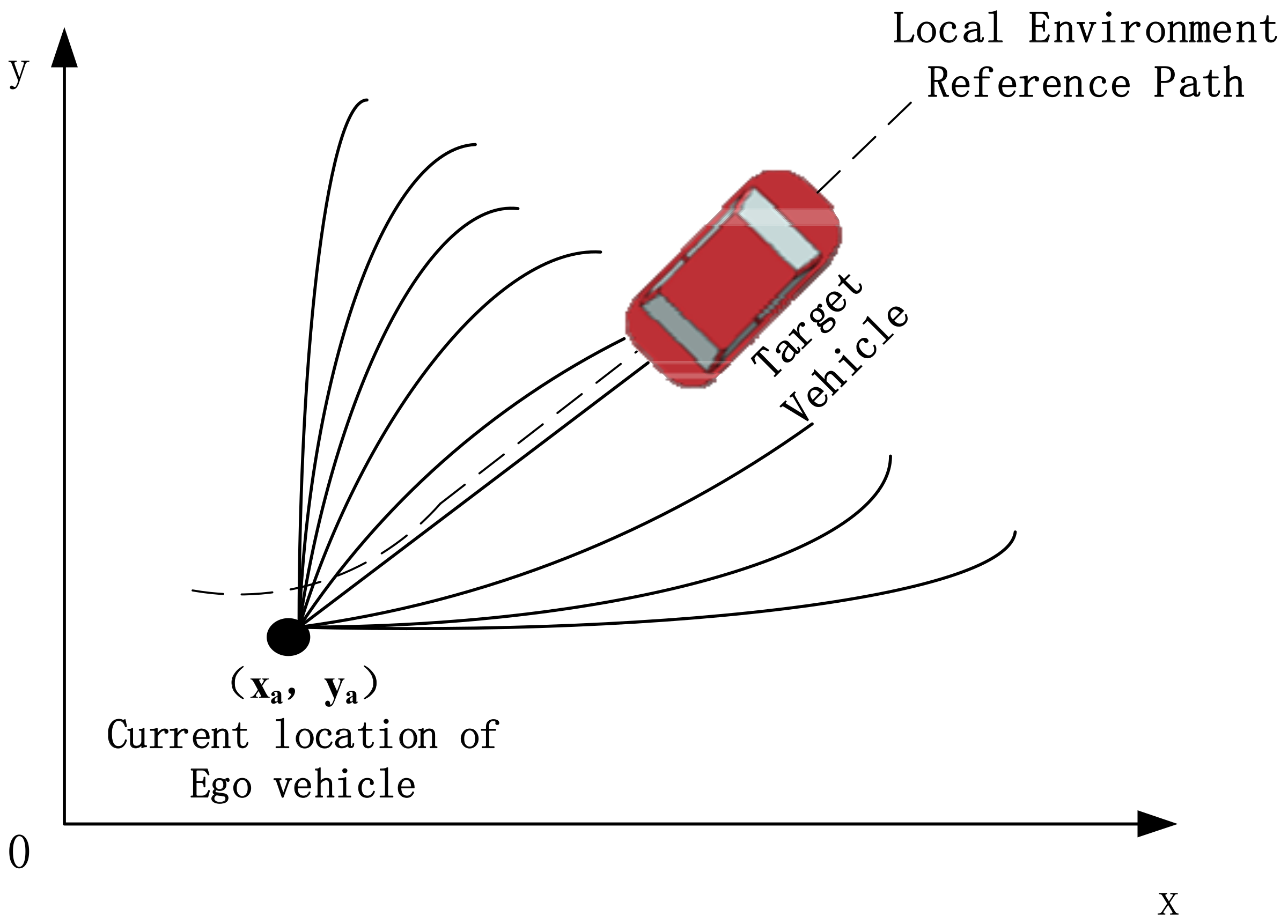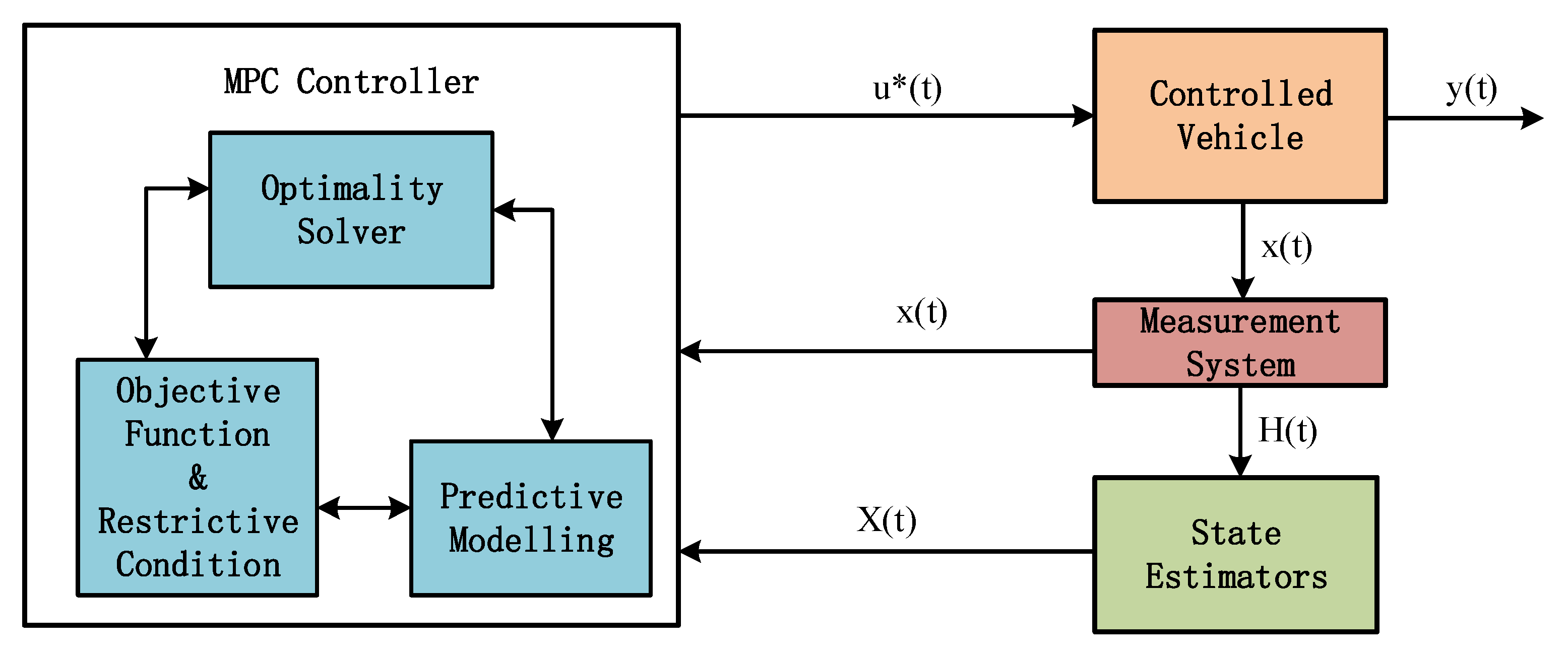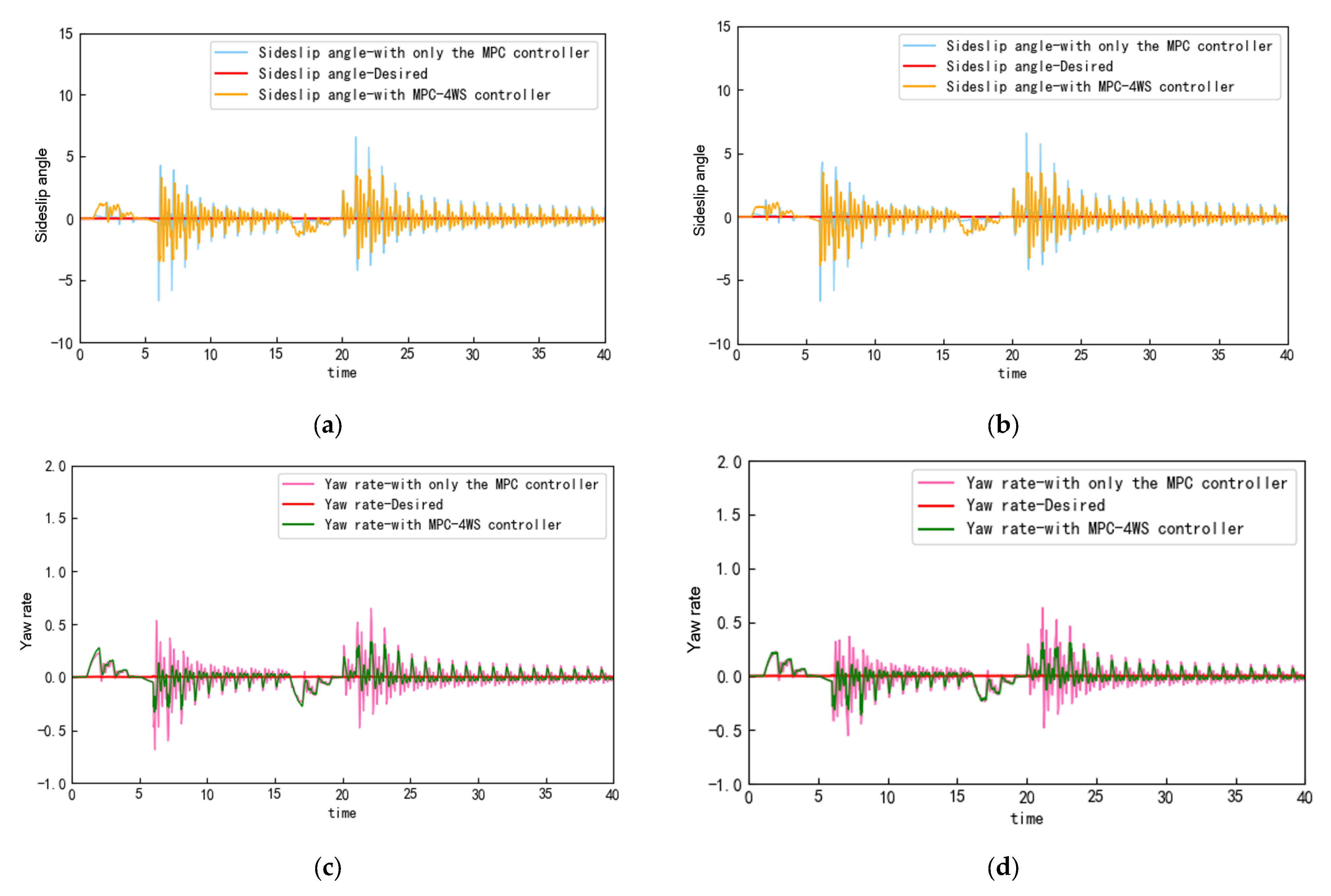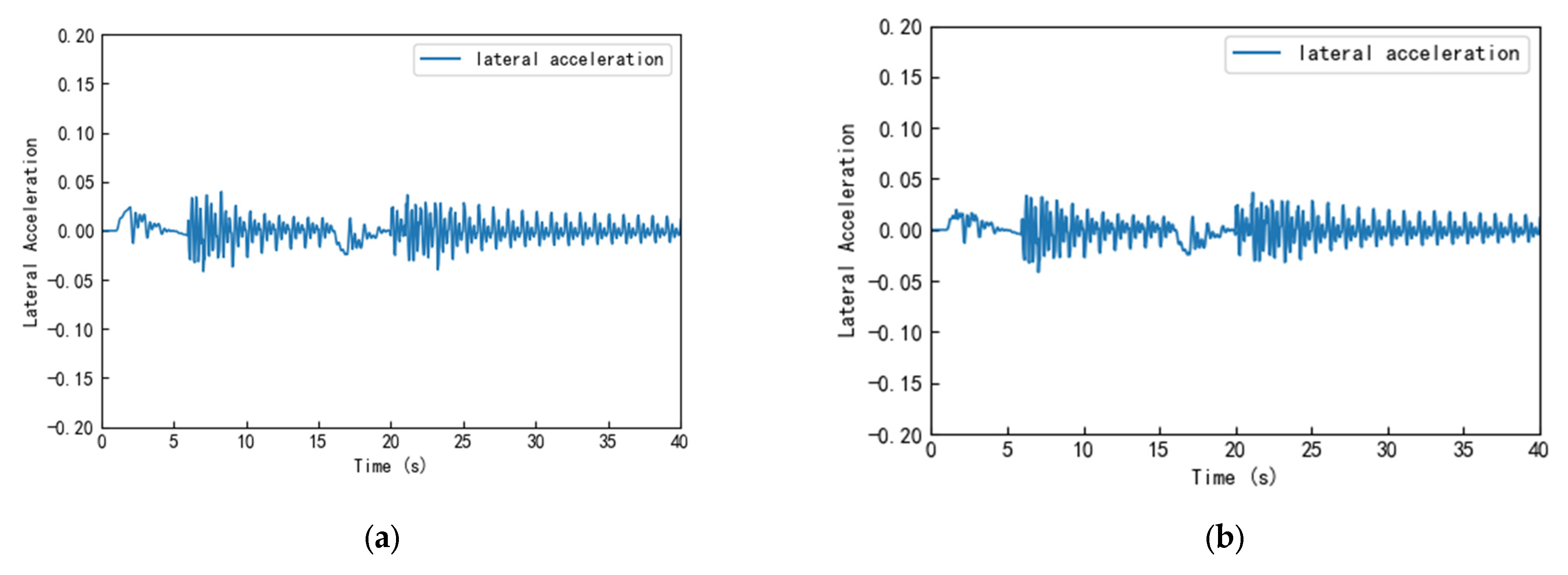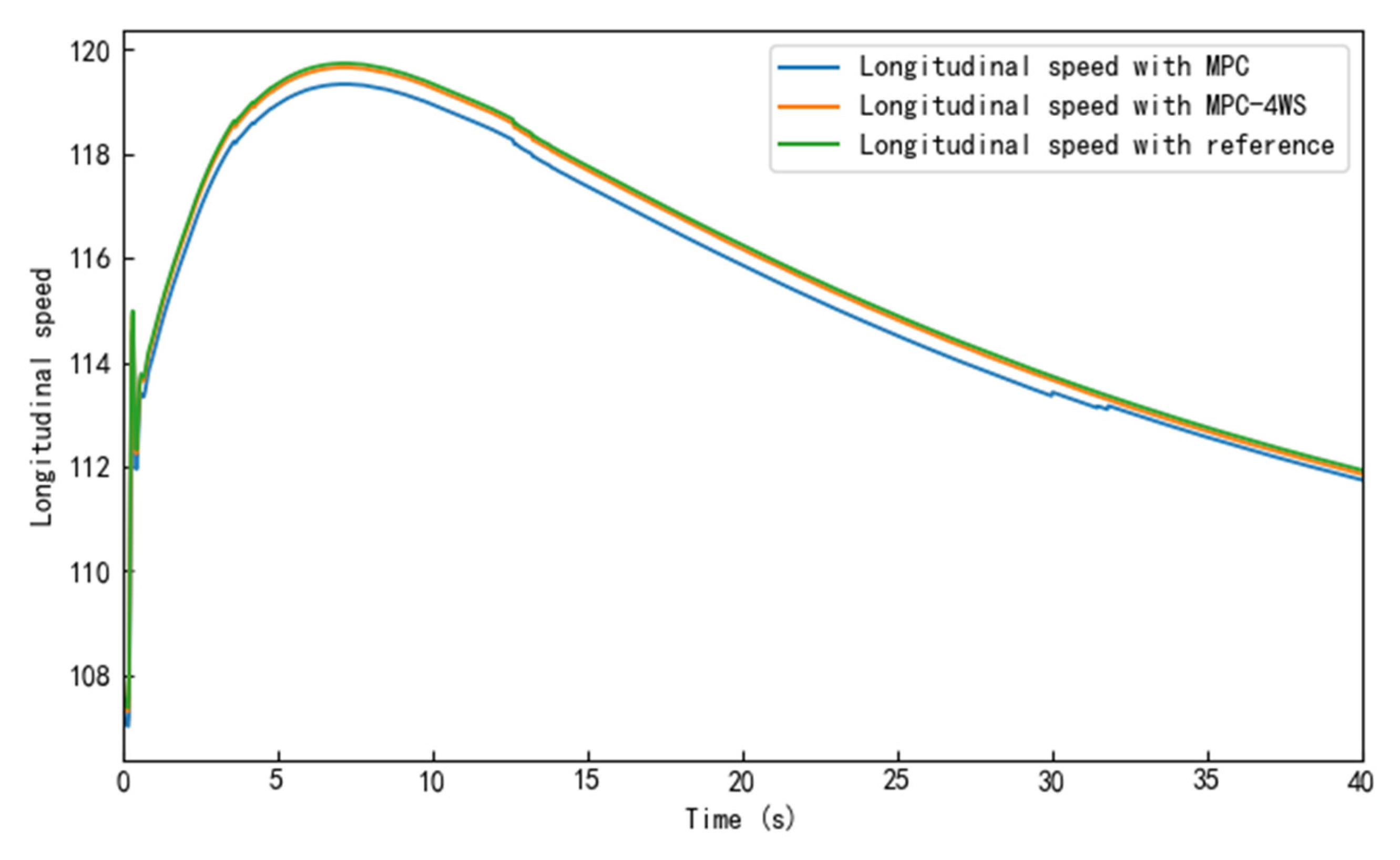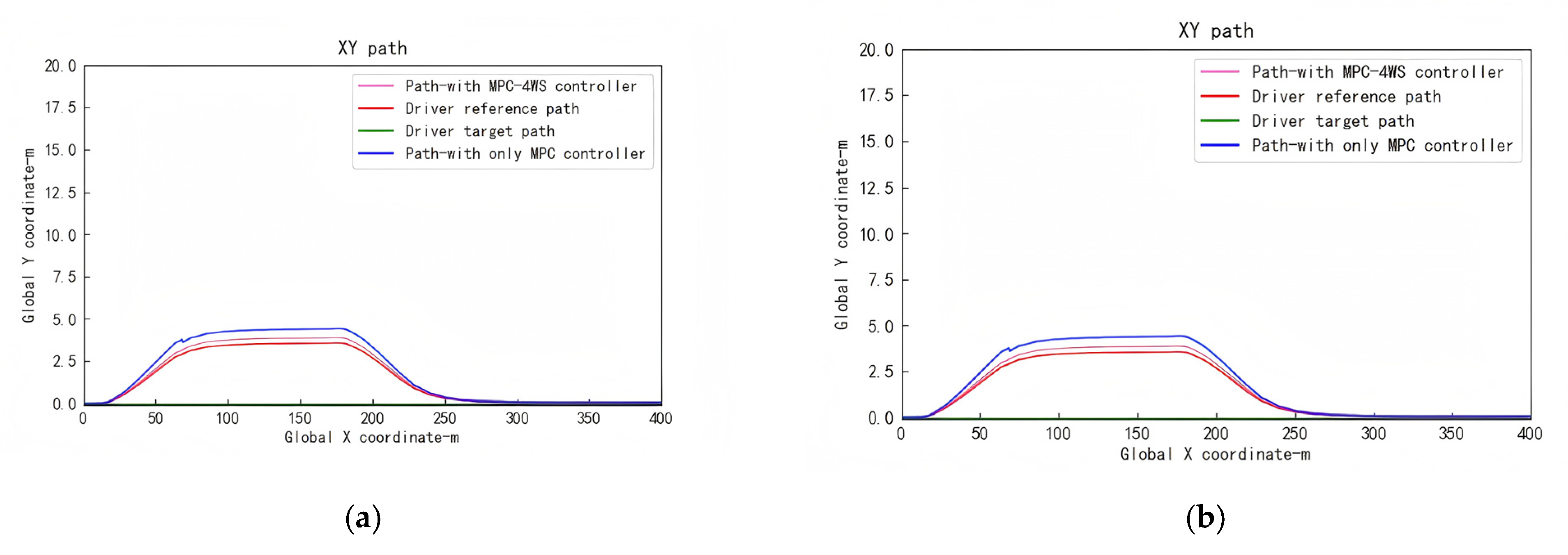1. Introduction
With the advancement of automotive intelligence and the maturation of steer-by-wire technology [
1,
2], automotive chassis systems are transitioning from traditional designs to steer-by-wire systems. This shift aims to achieve higher precision, faster response times, and improved safety. Motion control within these systems can be further categorized into longitudinal and lateral control. Longitudinal control involves coordinating the throttle and braking systems to precisely follow and control the desired vehicle speed. Lateral control, on the other hand, manages steering and path tracking in autonomous vehicles to ensure maneuvering stability, accurate path tracking, good drivability, and ride comfort.
Currently, a significant portion of research focuses on lateral control [
3,
4,
5,
6], utilizing various methods such as proportional–integral control to achieve lateral vehicle control [
7]. This method simplifies the tuning process and reduces computational complexity, offering flexibility in system performance adjustments. However, it may sacrifice potential performance by using only four parameters to control higher-order systems, potentially leading to inefficient control. Other approaches include fuzzy-based steering tracking control [
8,
9,
10], robust fuzzy control methods for lateral path tracking in autonomous vehicles [
11], and feedback–feedforward steering control strategies [
12,
13,
14]. These strategies combine static output feedback with dynamic feedforward methods to enhance lateral stability and performance during sudden lane change maneuvers. However, they are typically applicable to vehicles with front-wheel active steering or double combination types.
Additionally, Jie Zhang et al. [
15] proposed a novel active front steering control strategy, including upper and lower controllers, to improve yaw stability and maneuverability of steer-by-wire vehicles. However, this approach is also specific to vehicles with front-wheel active steering.
Most of the aforementioned control strategies target vehicles with active rear-wheel steering or active front-wheel steering. This often results in poor steering sensitivity and a tendency for excessive understeer at high speeds, seriously affecting maneuvering stability and safety.
As a key application of steer-by-wire technology, Four-Wheel Steering (4WS) has rapidly gained popularity due to its advantages in improving vehicle stability and maneuverability. Integrating 4WS technology with other control techniques further enhances overall vehicle safety and stability [
16,
17,
18,
19]. Numerous studies have been published on 4WS technology and its control strategies (Hang P [
16]). To address the vehicle stability control requirements and the uncertainty of the 4WS system, the stability control algorithms of four-wheel independent steering and four-wheel independent drive electric vehicles are investigated using 4WS coordinated control and direct swing moment control techniques and applying a linear variable parameter system and optimal control theory. And a polyhedral model is proposed to establish a system of four-wheel independent steering electric vehicles, which can improve the handling stability of the vehicle, especially under extreme working conditions, though it requires complex mathematical modeling and extensive computation to optimize controller parameters.
Other studies [
20] constructed nonlinear three-degree-of-freedom 4WS vehicle models for tracking ideal steering states, designing comprehensive controllers that integrate feedforward and feedback control. Simulation results demonstrated stable vehicle steering and effective resistance to external disturbances. Nathan A et al. [
21] proposed a neural network structure based on a physics-based feedforward–feedback control framework, utilizing past states and inputs driven by a physics model. This approach outperformed the physical model in experiments but requires substantial training data and extensive parameter tuning, posing risks of adversarial attacks that could mislead the neural network outputs, potentially threatening vehicle safety and stability.
Model Predictive Control (MPC) strategies have been widely applied in recent years [
17,
22,
23,
24,
25,
26]. Some studies [
27,
28] considered constraints on control inputs and state variables, proposing an MPC strategy based on nonlinear vehicle lateral dynamics for path-tracking control. However, these algorithms require online solving of nonlinear optimization problems, often failing to meet real-time requirements, especially at high vehicle speeds. Recent studies have emphasized the importance of accurately capturing vehicle nonlinear dynamics and enhancing handling stability for autonomous vehicles. For example, Ref. [
29] presents a deep-learning-based hybrid dynamic modeling framework coupled with an improved handling stability assessment specifically designed for vehicles operating at their driving limits. This approach demonstrates how data-driven methods can effectively capture complex vehicle behavior under extreme conditions. In parallel, Ref. [
30] reports on a hardware-in-the-loop real-time implementation of vehicle stability control using individual wheel torques, highlighting the feasibility of fine-grained control strategies to maintain stability in challenging driving scenarios.
Recent advances in adaptive control have demonstrated the effectiveness of combining dynamic performance criteria with robust control mechanisms. For instance, an adaptive fuzzy safety control scheme [
31] employs a sensing and adjustment mechanism to enable hypersonic flight vehicles to pursue prescribed behaviors safely under varying conditions. Similarly, an intelligent flight control strategy [
32] utilizes variable prescribed performance to dynamically adjust safety margins, enhancing overall system stability. Additionally, a discrete time-neural control approach [
33] incorporates flexible prescribed performance and fragility relaxation to robustly handle nonlinearities and constraints. These works collectively underscore the potential of adaptive, fuzzy, and neural methodologies in achieving robust control—a concept that inspires our approach to autonomous vehicle control.
Despite the numerous adaptive tracking control methods proposed, high-speed conditions with their time-varying and complex road environments present significant challenges. Increased tracking errors under these conditions challenge the performance of control algorithms effective at medium-to-low speeds, often resulting in decreased accuracy or instability. Complex control strategy modeling and computational demands further complicate matters. Advanced intelligent vehicle control typically includes Adaptive Cruise Control (ACC), Lane Keeping (LK), Lane Changing (LC), and overtaking. Among these, high-speed overtaking, involving interactions with other vehicles, is particularly challenging. Enabling autonomous vehicles to maintain high path-tracking accuracy while improving stability during high-speed lane-changing overtaking maneuvers presents substantial challenges.
To address these challenges, this study considers vehicle and road environment characteristics under high-speed conditions. It proposes a hybrid control strategy based on vehicle dynamics, integrating MPC and 4WS control, to enhance path-tracking during high-speed overtaking maneuvers while ensuring vehicle stability and maneuverability. The main innovations of this approach include:
Addressing the limitations of single control strategies, a hybrid control approach combining MPC and 4WS control is proposed, with a 2-degree-of-freedom (2DOF) ideal model designed as the path-tracking-response model. This offers flexibility to adapt to complex, dynamic road environments at high speeds, effectively overcoming performance degradation issues of traditional control algorithms, enhancing the accuracy and robustness of path tracking, and balancing vehicle maneuverability and stability.
Incorporating yaw rate and lateral deviation angle into the hybrid control model to address increased path-tracking errors from time-varying road conditions at high speeds. This allows for a precise capture of vehicle dynamic behavior, resulting in better path-tracking responses. Real-time adjustments by the MPC controller contribute to more accurate path tracking.
Utilizing the Carsim–Simulink simulation platform to simulate various road and vehicle environments, including double-lane change scenarios, reducing research costs and safety risks. This approach effectively validates the model controller’s feasibility. Experimental results demonstrate that the proposed integrated control strategy significantly enhances autonomous vehicle maneuvering in high-speed double-lane change scenarios.
The structure of the subsequent section is as follows: In
Section 2, we delve into the challenges of high-speed lane changing and overtaking on a dual-lane highway and outline our design objectives.
Section 2.2 introduces the vehicle model used in this work. In
Section 3, we propose an integrated hybrid control strategy for four-wheel steering control and path tracking to enable autonomous vehicles to perform high-speed overtaking maneuvers. This section also details the working principles and goals of each controller component.
Section 4 presents the evaluation metrics, experimental setup, vehicle parameter configuration, simulation results, and comparative analysis of our designed control strategy, followed by a discussion in
Section 5. Finally,
Section 6 summarizes the research findings and outlines future research directions.
3. Methodology
Considering that the nonlinear characteristics of the tire side deflection angle under high speed and complex working conditions have a significant impact on the vehicle control, this paper designs a controller (MPC-based controller) based on the fusion of nonlinear MPC and quintuple polynomial algorithm based on the nonlinear 2-degree-of-freedom (2DOF) dynamics model of a four-wheel-steering vehicle in order to decode the front wheel angle based on the real-time state of the vehicle and the reference path to achieve the precise control of the vehicle’s front wheels. Meanwhile, in order to improve the vehicle’s maneuvering stability and real response performance, the 2DOF ideal model is selected as the response model for path tracking. This model calculates the desired traverse angular velocity according to the vehicle motion state. In addition, to ensure the stability of the vehicle at high speeds, the desired center-of-mass lateral deflection angle of the vehicle is set to 0 (βd = 0), and the outputs ωd and βd are simultaneously used as one of the inputs of the 4WS controller.
The 4WS controller calculates the steering angles of the vehicle’s left and right rear wheels and inputs them to the vehicle model, enabling the vehicle to realize precise control of the rear wheels while tracking the desired traverse angular velocity and center-of-mass lateral deflection angle. Ultimately, the self-driving vehicle is able to realize four-wheel steering control and path tracking through the cooperative hybrid control based on the MPC-based controller, the 4WS-based controller, and the ideal model. The overall strategy schematic is shown in
Figure 3.
The control strategy consists of four modules: the MPC-based controller shown in
Figure 3, the 4WS controller, the 2DOF ideal model, and the controlled vehicle and road information.
3.1. Path-Planning Methods
To ensure that the autonomous vehicle achieves higher accuracy in path tracking during lane-changing overtaking maneuvers on highways with dual-lane scenarios and to smooth its motion trajectory, we employ a path-planning algorithm based on fifth-order polynomials within the controller, implemented using Matlab–Simulink. This approach transforms the problem into finding a curve that connects two specified target points (current position and target position) while satisfying requirements such as fixed desired velocity, acceleration, and heading angle at the target points, as illustrated in
Figure 4.
Initially, multiple lookahead points along the reference path are identified using various distances. For each lookahead point, candidate target poses with different lateral deviations are generated along its normal direction. The corresponding travel curves form a candidate set. A collision analysis is then performed by comparing vehicle dimensions along each curve with the positions of forward vehicles, retaining only the segments prior to any collision points. Among curves with identical lateral deviations, the longest one is chosen. Finally, a single travel curve that meets both safety and path-tracking requirements is selected as the desired path for the overtaking maneuver.
The construction of a fifth-order polynomial curve allows for the analysis of three state values: displacement, velocity, and acceleration of an object. The fifth-order polynomial takes the following form:
where
x and
y represent the fifth-order polynomials of the vehicle’s lateral and longitudinal positions with respect to time
t. By further differentiating them, we obtain the velocity and acceleration curves of the vehicle, denoted as:
The polynomial curves vary over the time domain. Let
t0 be the initial time of the vehicle and
t1 be the final time. We solve the position, velocity, and acceleration state equations and represent them in matrix form. Here, X and Y represent the longitudinal and lateral motions, respectively.
Its implementation in Matlab 2021 is shown in
Figure 5:
3.2. MPC-Based Controller Design
This work focuses on the path tracking of autonomous vehicles during overtaking maneuvers in high-speed dual-lane scenarios, necessitating the use of a controller with fast computation speed and excellent real-time performance. Therefore, an MPC approach based on a linear model is adopted. The fundamental concept of MPC is to use existing models, the current system state, and future control inputs to predict the system’s future outputs. This is accomplished by solving a constrained optimization problem to effectively control the front wheels.
The principal block diagram of MPC is shown in
Figure 6, consisting of three modules: the MPC controller, the controlled vehicle, and the state estimator. In this diagram, the MPC controller integrates the predictive model with the objective function and constraints to solve an optimization problem, obtaining the optimal control sequence u*(t) at the current time. This control sequence is then applied to the controlled vehicle, which adjusts to the current control inputs and outputs the optimal front wheel steering angle, y(t). The state variable x(t), which is observed through the measurement system, will be directly input into the MPC module, while the state quantity H(t), which cannot be directly observed or is too costly to measure, is estimated through an estimator. The estimated state quantity X(t) is then fed back into the MPC controller, which performs another optimization to obtain the control sequence for the next time period.
We convert this problem process into a quadratic planning problem, where the model predictive control is based on the model’s prediction of future outputs within a prediction step and solves the quadratic planning problem according to the prediction objective to obtain a future decision series. The discrete system state-space equations are as follows:
We define
T1,
T2,
T3 in that case as
Denote the above expression as:
To ensure smooth and accurate tracking of the overtaking path by the vehicle and to avoid encountering unsolvable situations, we adopt the following objective function:
where
a denotes the constant term and
denotes the reference system state.
Thus, the objective function
can be expressed in quadratic form as
3.3. 2DOF Ideal Model: Ideal-State Variable Calculation
To enhance the vehicle’s handling stability and responsiveness to driver inputs, as well as the flexibility of the control strategy, and ultimately improve the vehicle’s maneuverability, we incorporate a 2-degree-of-freedom (2DOF) ideal model as the path-tracking response model. In this 2DOF ideal model, we consider both the yaw rate and the lateral deviation angle of the center of gravity to better capture the vehicle’s dynamic behavior. These parameters are included in the derivation of the ideal yaw rate formula. Using this model, we compute the desired yaw rate and lateral deviation angle, which are then sent to the 4WS controller as input variables. The controller calculates the required desired yaw rate based on the front wheel steering angle and the vehicle’s motion state, as shown in Equation (31).
where
v is the vehicle speed,
is the front wheel turning angle,
i is the fixed transmission ratio,
ib is the variable steering transmission ratio, and
K is the vehicle stability parameter, which can be obtained from Equation (32).
where
m is the vehicle mass,
l is the wheelbase,
and
are the distances from the center of mass to the rear and front axles, and
and
are the lateral-deflection stiffnesses of the front and rear wheels, respectively.
When the vehicle performs steering maneuvers such as lane changes, the maximum lateral acceleration achievable by the vehicle is limited by the coefficient of friction
µ between the tires and the road surface. Typically, dry, well-maintained asphalt or concrete surfaces have higher coefficients of friction, ranging from 0.7 to 0.85. In the simulated highway environment considered in this paper, where road conditions are relatively good, we assume
µ to be 0.85. Therefore, the actual desired yaw rate, constrained by the coefficient of friction of the road surface, can be expressed as:
Since the response of the yaw rate to the front wheel steering angle can be approximated as a first-order time-delay system, the final desired yaw rate can be expressed as:
where
represents the time delay of the first-order time-delay system,
v is the vehicle speed, and
g is the gravitational acceleration, with specific numerical values as shown in
Table 1. Additionally, to ensure the stability of the vehicle at high speeds, the desired lateral deviation angle of the vehicle (
) is set to 0. i.e.,
.
3.4. 4WS Controller Design
In the field of vehicle dynamic control, establishing a precise and stable control model for the steering system is challenging but crucial for enhancing driving safety and comfort, particularly at high speeds and under complex road conditions. Traditional control methods, such as PID control, often perform poorly when dealing with the nonlinear characteristics of vehicles and external disturbances, posing challenges for improving steering accuracy and stability. To address this issue, we designed a 4WS controller incorporating sliding mode control (SMC) to achieve precise control of the rear-wheel steering angle. In our approach, the SMC-based 4WS controller receives inputs from both the 2DOF ideal model and the vehicle’s actual state, including the front wheel steering angle, the ideal yaw rate, the ideal center-of-gravity sideslip angle, the actual yaw rate, and the actual center-of-gravity sideslip angle, and processes these signals to generate the appropriate rear-wheel steering commands. Sliding mode control is a nonlinear control method renowned for its robustness and excellent control performance. By designing a sliding surface that constrains the system state to move along this surface, SMC effectively mitigates the effects of system parameter variations and external disturbances. This enables rapid adjustment of the system dynamics and ensures robust stable control, thereby improving the stability and accuracy of the vehicle’s steering behavior.
First, we take the errors of the vehicle’s centroid sideslip angle and yaw rate,
and
as the sliding surface for the sliding mode control, which can be expressed as:
where
Taking the derivative of the sliding surface, we obtain:
To suppress the chattering of the sliding mode structure and ensure system stability, while allowing the system to quickly approach the sliding surface, we design the approach rate of the sliding surface as:
where ε and
are diagonal gain matrices. Therefore, combining the approach rate of the sliding surface, Equation (30) can be expressed as:
Combining with the dynamic differential equations from Equations (12)–(14) and (35), we define:
Thus, Equation (33) can be expressed as:
Therefore, the rear-wheel steering angle
can be solved as:
5. Discussion
To evaluate the accuracy and stability of the proposed control strategy’s path-tracking system, we compared the relative proximity of the vehicle’s XY driving path curves to the reference path over a 400 m distance using both the MPC controller and the MPC-4WS hybrid controller. The experimental results, shown in
Figure 10, indicate that the control and path-tracking performance of the designed MPC-4WS hybrid controller are superior to those of the standalone MPC controller.
Comparison with the reference path reveals that the driving path of the hybrid MPC-4WS controller significantly outperforms that of the single MPC controller throughout the entire 400 m driving distance from the start of overtaking to switching to the left lane and then returning to the original lane. Specifically, in the overtaking phase, the traveling path error of the MPC-4WS controller is reduced by 65.88%, and the maximum error with respect to the reference path is reduced by about 0.553 m from 0.8633 m of the single MPC controller to 0.3102 m, while the path curve is smoother, reflecting its superior path-tracking performance. In addition, the actual traveling path of the vehicle is highly consistent with the ideal reference path, almost perfectly reproducing the preset path.
Further analysis of the shape and trend of the path curves shows that the vehicle gradually approaches the reference path during the driving process after completing the overtaking, and the deviation gradually decreases and finally overlaps with the target path completely. This indicates that the designed path-tracking system possesses excellent stability and is able to consistently approach the target path during the driving process, avoiding significant deviations or jerks.
In summary, the experimental results fully demonstrate the significant advantages of the proposed MPC-4WS hybrid control strategy in terms of path-tracking accuracy and stability, which effectively improves the maneuverability and safety of self-driving vehicles in high-speed scenarios.
6. Conclusions
This paper focuses on the overtaking problem of autonomous vehicles in high-speed conditions. It investigates a fusion control strategy that combines Model Predictive Control (MPC) and Four-Wheel Steering (4WS) to enable autonomous vehicles to smoothly perform lane-changing maneuvers at high speeds while ensuring vehicle maneuverability, stability, and good path-tracking performance.
Considering the need for a fast and real-time controller for path tracking during overtaking maneuvers of autonomous vehicles in high-speed dual-lane scenarios, this study adopts an MPC-based linear model predictive controller. The problem is formulated as a quadratic programming problem to determine the front-wheel steering angle and future decision behavior of the vehicle. To ensure accurate path tracking and smooth vehicle motion, a fifth-degree polynomial path-planning algorithm is incorporated into the controller and implemented using Matlab–Simulink.
To accurately capture the vehicle’s dynamic behavior, improve responsiveness to driver inputs, enhance control flexibility, and achieve good maneuvering stability, this work proposes a 2DOF (degrees of freedom) ideal model as the path-tracking response model. The model considers the yaw rate and center of gravity lateral displacement and calculates the ideal yaw rate and ideal lateral displacement using derived formulas. These values are then fed as inputs to the 4WS controller responsible for rear-wheel control. This approach ensures a good path-tracking response of the vehicle in high-speed dual-lane scenarios.
To address issues of insufficient steering precision and stability deterioration during high-speed driving and complex road conditions, this paper introduces sliding mode control to establish a precise and stable control model for accurate control of the rear-wheel steering angle. A sliding surface is designed to force the system state to move on this surface, effectively overcoming the effects of system parameter variations and external disturbances, achieving fast dynamic adjustment and a robust, stable control of the system.
The joint simulation results of Carsim–Simulink indicate that the closed-loop control strategy system constructed in this paper can effectively suppress the lateral and yaw motions of the vehicle in high-speed dual-lane scenarios. It exhibits good stability and disturbance rejection capabilities, keeps the vehicle moving within a safe range, and achieves high-precision path tracking, thereby ensuring the maneuverability and safety of autonomous vehicles.
In summary, this paper proposes a hybrid control strategy based on MPC and 4WS, incorporating a 2DOF ideal model that considers yaw rate and center of gravity lateral displacement as the response model. The aim is to enable autonomous vehicles to achieve good path-tracking performance while ensuring vehicle maneuverability, safety, and stability in high-speed dual-lane scenarios.
Future research will focus on optimizing control strategy parameters, integrating alternative predictive control algorithms, and enhancing environmental perception (e.g., with higher-precision sensors) to reduce performance fluctuations during lane changes. Additional studies will address improved steering stability and overall path-tracking performance in complex, dynamic environments. Moreover, we will explore advanced control strategies such as prescribed performance control (PPC), which pre-defines error convergence trajectories and performance indices to impose strict system constraints while enhancing accuracy and responsiveness. Compared to the current MPC-4WS hybrid approach, PPC may offer superior robustness against nonlinear uncertainties and dynamic changes, and future work will evaluate its integration with our method for high-performance path tracking under challenging conditions. In addition, future research may also develop adaptive control strategies that dynamically adjust key parameters—such as the MPC-weighting matrices—based on individual driver-overtaking styles and preferred speed ranges, thereby further enhancing system adaptability and performance across diverse driving behaviors.



